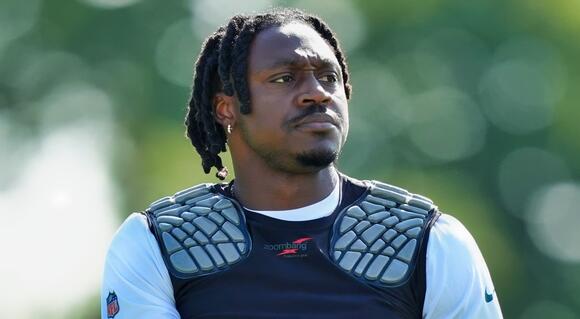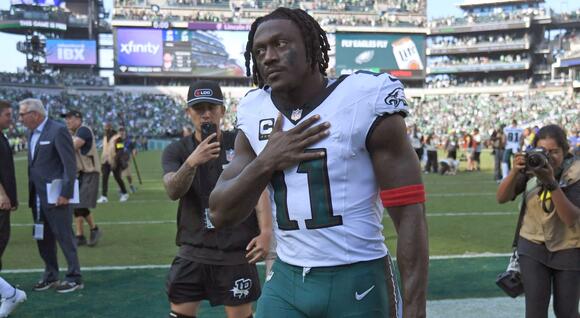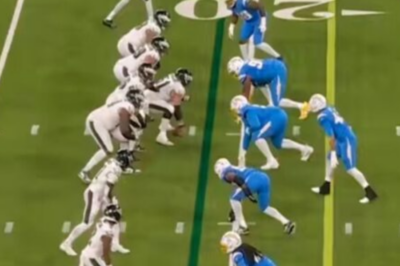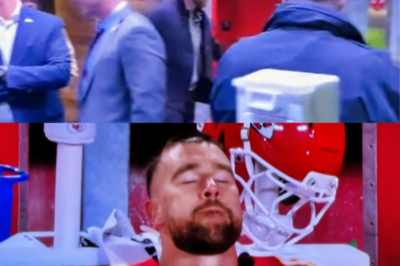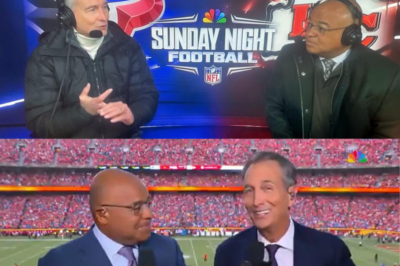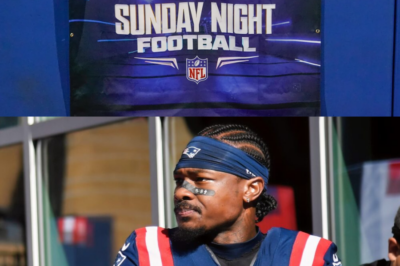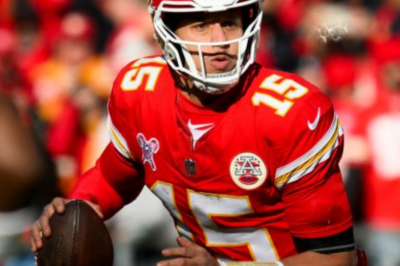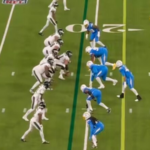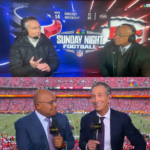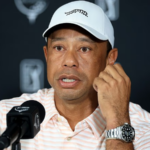BREAKING: Eagles to trade A.J. Brown. This isn’t a drill. Find out why the front office is making a move that will infuriate the entire city.
In a development that has sent seismic waves through the National Football League, multiple league sources are reporting that the Philadelphia Eagles are actively engaging in trade discussions involving their cornerstone offensive weapon, wide receiver A.J. Brown.
This is not a mere rumor mill churn; this is a potential tectonic shift for a franchise that, just over a year ago, was playing in the Super Bowl.
The mere notion of trading Brown—a prolific, record-shattering talent who has become the identity of the Eagles’ offense—is so staggering that it forces a fundamental reevaluation of the team’s present constitution and future aspirations.
This report will delve into the multi-layered implications of this bombshell, examining the potential motivations of General Manager Howie Roseman, the profound on-field consequences, the seismic impact on the locker room and fanbase, the intricate financial and salary cap ramifications, and the broader reverberations across the NFL landscape.
The Bombshell Report – Context and Immediate Fallout
The news broke not with a whisper, but with a roar. On a seemingly ordinary afternoon during the NFL’s offseason program, esteemed insiders like Adam Schefter of ESPN and Ian Rapoport of NFL Network released near-simultaneous reports indicating that the Philadelphia Eagles’ front office was “listening to calls” and “exploring the market” for A.J. Brown.
The initial public and media reaction was a uniform blend of disbelief and outright denial. This is A.J. Brown we are talking about—not a role player, not a declining veteran, but a bonafide superstar in his absolute prime.

To understand the shock, one must recall the context of Brown’s arrival. After a celebrated but sometimes frustrating tenure with the Tennessee Titans, Brown was acquired via a blockbuster trade during the first night of the 2022 NFL Draft.
Howie Roseman, the Eagles’ executive vice president and de facto architect, swiftly signed him to a four-year, $100 million contract extension.
The move was immediately hailed as a masterstroke. It provided young quarterback Jalen Hurts with a true, dominant number-one receiver, a weapon he desperately needed to elevate his game and the entire offense.
The results were nothing short of spectacular. In his first season in midnight green, Brown amassed 1,496 receiving yards and 11 touchdowns, earning First-Team All-Pro honors and propelling the Eagles to a dominant NFC Championship and a narrow loss in Super Bowl LVII.
He followed that in 2023 with 1,456 yards and 7 touchdowns, again being selected to the Pro Bowl. He and Hurts developed a chemistry that was both palpable and productive, a connection that became the engine of the Eagles’ offensive identity.
Therefore, the report of his potential departure is not merely a transaction; it feels like a philosophical divorce from the very blueprint that brought the team to the brink of a championship.
The immediate fallout was a social media firestorm. The phrase “A.J. Brown” trended nationally on platform X (formerly Twitter), with Eagles fans expressing a spectrum of emotions from rage to profound confusion.
Teammates, while largely cautious in their public statements, began “liking” and engaging with posts related to the news, a digital tell that signaled their own surprise. The narrative was set: this was the story that would dominate the NFL offseason.
Deconstructing the “Why” – The Roseman Calculus
To the average fan, trading A.J. Brown seems like organizational malpractice. However, to understand the potential logic, one must step into the war room of Howie Roseman, a general manager renowned for his aggressive, forward-thinking, and sometimes coldly pragmatic team-building philosophy.
There is no single reason that would lead to such a momentous decision, but rather a confluence of interconnected factors.
The Financial and Salary Cap Domino Effect
The NFL is a hard-cap league, and managing the cap is a complex, multi-year puzzle.
The Eagles have made significant financial commitments to a core of players, headlined by quarterback Jalen Hurts, who signed a landmark $255 million extension in 2023.
Other massive contracts include those for offensive tackle Lane Johnson, defensive end Haason Reddick (recently traded), and cornerback Darius Slay. A.J. Brown’s $25 million annual average was a key part of that financial structure.
However, the cap is fluid. Trading Brown before June 1st would result in a significant dead money hit of over $28 million for 2024, a daunting figure.
But a post-June 1st designation would allow the Eagles to spread that cap charge, creating more immediate flexibility. The long-term view is crucial.
By moving Brown’s contract now, the Eagles would free up tens of millions in future cap space, allowing them to address other glaring needs on the roster—specifically on defense, which was historically bad in the latter half of the 2023 season.
This capital could be used to extend other young talents, sign multiple impactful free agents, and create a more balanced, deep roster rather than one top-heavy with a few superstar contracts.
Philosophical Shift and Offensive Evolution
The 2023 season ended in a catastrophic collapse. After a 10-1 start, the Eagles stumbled to a 1-6 finish, including a Wild Card round playoff loss.
The offense, under then-offensive coordinator Brian Johnson, became predictable and stagnant. Head Coach Nick Sirianni responded by making a dramatic change, firing Johnson and hiring the renowned offensive mind Kellen Moore.
Moore’s offensive system is distinct. While it certainly utilizes elite wide receivers, its foundation is often built on timing, route diversification, and maximizing the run game.
There is a school of thought within league circles that suggests the Eagles might be considering a move away from a “force-feed the alpha receiver” model towards a more egalitarian, system-based passing attack.
This is not to say Brown doesn’t fit any system—he’s too talented for that—but it might indicate a desire to build an offense less reliant on a single, dominant target and more on scheme and versatility.
The presence of DeVonta Smith, a supremely talented receiver in his own right, and the recent signing of running back Saquon Barkley, a premier pass-catching back, gives Moore the pieces to run such an offense.
The Draft Capital Equation
Howie Roseman has consistently proven that he values premium draft capital above almost all else. Trading A.J. Brown, a 26-year-old established superstar, would undoubtedly command a massive return.
The baseline for such a trade would likely be multiple first-round picks, or a first-round pick plus other high-value selections and/or players.
For a team looking to retool on the fly, this is an incredibly powerful lure. Acquiring, for example, two first-round picks would give Roseman immense ammunition to infuse the roster with young, cost-controlled talent on both sides of the ball.
It would allow the Eagles to build a sustainable contender for the remainder of Jalen Hurts’ prime, rather than being cap-strapped and top-heavy.
This is the “Bill Belichick” model of team-building that Roseman has often admired: accumulate picks, maintain flexibility, and avoid emotional attachments to players.
The On-Field Void – How Do You Replace 1,400 Yards?
The statistical output of A.J. Brown is not easily replicated. He is one of only a handful of receivers in NFL history to surpass 1,400 receiving yards in each of his first two seasons with a new team.
His combination of size, strength, physicality, and route-running savvy makes him a matchup nightmare. He commands double-teams, opens up the field for other receivers, and is a dominant force in the critical yards-after-catch (YAC) category.
Without him, the Eagles’ offense would look dramatically different. DeVonta Smith would immediately ascend to the WR1 role, a position he is certainly capable of handling from a talent perspective. However, the attention he would draw from opposing defenses would intensify exponentially.
The question then becomes: who is the WR2? The current depth chart features players like Parris Campbell, and Britain Covey—talented individuals, but none who strike fear into a defensive coordinator.
The Eagles would be thrust into the market for a replacement, either through the draft, where they would likely need to use a high pick, or via free agency or trade, where the options are limited and expensive.
The notion of replacing Brown’s production with a single player is a fantasy; it would have to be a “by-committee” approach, which is inherently less reliable.
Furthermore, the impact on Jalen Hurts cannot be overstated. The Hurts-to-Brown connection was more than just statistics; it was a safety blanket, a trust fall on critical third downs and in the red zone.
Hurts developed an almost telepathic rapport with Brown, often throwing to a spot before Brown had even made his break.
Removing that element from the offense places a greater burden on Hurts to be perfect, to progress through his reads more meticulously, and to build a new chemistry with a different set of pass-catchers. In the high-stakes world of the NFL, that process takes precious time—a commodity that is never in abundant supply.
The Human Element – Locker Room and Fanbase Reactions
Football is a business, but it is played and followed by people. The human element of this potential trade is perhaps its most volatile aspect.
The Jalen Hurts Factor
The relationship between a franchise quarterback and his primary receiver is sacred. Jalen Hurts and A.J. Brown are not just teammates; they are close friends and mutual supporters. Brown was instrumental in Hurts’ development as a passer, providing a constant, reliable target who could win one-on-one battles consistently.
Trading Brown would be a decision made over the head of the franchise quarterback, a move that could potentially create a rift between Hurts and the front office. While Hurts is a consummate professional, the psychological impact of losing his top weapon and confidant could be significant.
The front office would be betting that Hurts’ leadership and professionalism would allow him to overcome this and elevate the players around him—a massive gamble with the team’s most important asset.
The Locker Room Dynamics
A.J. Brown is a leader. He is vocal, passionate, and sets a standard of excellence. His “Stripe up!” mantra from the 2023 season became a rallying cry.
Trading such a central figure sends a powerful, and potentially unsettling, message to the rest of the locker room. It communicates that no one is safe, that production and popularity are no guarantee of job security.
This can be a double-edged sword. It can foster a hyper-competitive environment, but it can also erode trust and create a sense of instability. Players may begin to wonder, “If they can trade A.J., they can trade anyone.” Maintaining morale and a unified culture would become an immediate and critical challenge for Head Coach Nick Sirianni.
The Philadelphia Fanbase’s Fury
Philadelphia fans are known for their passion, knowledge, and, at times, their ferocity. The acquisition of A.J. Brown was celebrated as a triumph.
He embodied the city’s blue-collar, tough, and relentless spirit. Trading him away after two historically great seasons would be seen by many as a betrayal, a sign that the organization is not fully committed to winning a championship right now.
The backlash would be immediate, intense, and sustained. It would put immense pressure on Howie Roseman and the entire Eagles organization. Every dropped pass, every offensive struggle in the 2024 season would be met with a chorus of “should have never traded A.J.”
The front office’s relationship with its fanbase would be severely tested, and the only thing that could repair it would be immediate, tangible success on the field.
The League-Wide Implications – A New Arms Race
An A.J. Brown trade would not happen in a vacuum; it would trigger a seismic shift across the NFL. A player of his caliber becoming available is an extremely rare event, and it would instantly create a frenzied bidding war among contending teams.
Who are the potential suitors? The list is long and compelling. The Kansas City Chiefs, always looking to provide Patrick Mahomes with more weapons, would be a logical fit.
The New York Jets, in a “win-now” mode with Aaron Rodgers, could see Brown as the final piece. The Jacksonville Jaguars, looking to maximize Trevor Lawrence’s window, could be a dark horse.
The Chicago Bears, armed with cap space and a young QB in Caleb Williams, could make an aggressive move to accelerate their rebuild. The San Francisco 49ers, despite their wealth of weapons, are never afraid to make a bold move.
Wherever Brown lands, it would instantly catapult that team’s offense into a higher echelon and dramatically alter the power balance within their conference.
The return the Eagles receive would set a new market value for elite, prime-aged receivers, impacting future contract negotiations and trades for other stars.
The ripple effects of this single transaction would be felt for years, influencing draft strategies, free agency plans, and the championship aspirations of a dozen franchises.
A Crossroads for the Franchise
The report that the Philadelphia Eagles are considering trading A.J. Brown is more than just a headline; it is a defining moment for the organization.
It represents the ultimate conflict between cold, analytical team-building and the emotional, visceral nature of sports.
Howie Roseman is playing a high-stakes game of multidimensional chess, betting that his long-term vision of a balanced, financially flexible, and sustainably competitive roster is more valuable than the short-term security of a superstar receiver.
If he executes this trade and the Eagles thrive, he will be hailed as a visionary, a guru who had the courage to make an unpopular but correct decision.
If he trades Brown and the offense sputters, if Jalen Hurts regresses, and if the team fails to meet expectations, the decision will be remembered as one of the most catastrophic miscalculations in modern Philadelphia sports history.
The weight of this potential move is immense, carrying consequences for the franchise’s trajectory, the legacy of its key figures, and the hearts of its millions of fans. The entire NFL world now watches and waits, anticipating the next move in a storyline that has shaken the league to its core.
News
UNBELIEVABLE: Jalen Hurts makes NFL history in the worst way possible. You have to SEE this double-turnover play to believe it.
UNBELIEVABLE: Jalen Hurts makes NFL history in the worst way possible. You have to SEE this double-turnover play to believe it. In…
SHOCKING VIDEO: Never-Before-Seen Video of Travis Kelce’s Meltdown After Chiefs’ Brutal Loss Will Leave You Speechless.
SHOCKING VIDEO: Never-Before-Seen Video of Travis Kelce’s Meltdown After Chiefs’ Brutal Loss Will Leave You Speechless. In an unprecedented turn…
NFL Fans Express Frustration Over Cris Collinsworth’s Commentary During Chiefs-Texans Sunday Night Football Game
NFL Fans Express Frustration Over Cris Collinsworth’s Commentary During Chiefs-Texans Sunday Night Football Game The NFL’s Sunday Night Football game…
BREAKING: The NFL just BLINDSIDED everyone with a massive Week 16 “Sunday Night Football” swap. You won’t BELIEVE which rivalry got the prime-time slot—it’s a perfect storm for fans and teams.
BREAKING: The NFL just BLINDSIDED everyone with a massive Week 16 “Sunday Night Football” swap. You won’t BELIEVE which rivalry…
Seahawks Star DK Metcalf Removed From Flight, Rushed to Hospital Following Ravens Win. Shocking details emerging.
Seahawks Star DK Metcalf Removed From Flight, Rushed to Hospital Following Ravens Win. Shocking details emerging. In a shocking turn…
NBC just made a drastic decision during Chiefs-Texans, cutting away from a live on-field incident deemed “too gruesome” to air. What did they NOT want you to see? The controversy is exploding.
NBC just made a drastic decision during Chiefs-Texans, cutting away from a live on-field incident deemed “too gruesome” to air….
End of content
No more pages to load

